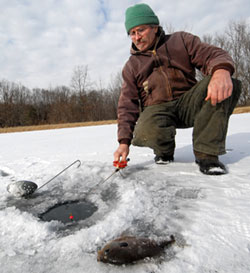When in doubt, don't go out!
Beware of thin ice
WARN KIDS ABOUT PLAYING ON FROZEN LAKES AND STREAMS WITHOUT SUPERVISION.

Every winter, thousands of Hoosiers enjoy fishing, skating, hiking or just sliding around on frozen ponds and lakes. And every year, people drown after falling through ice. Like driving on snow, Hoosiers need to re-learn how to have safe fun on ice.
If you are fishing:
- Drill your own test hole near shore. Your test hole should show at least a four-inch thickness of clear ice like you get from your freezer.
- Wear a life jacket for extra warmth and safety.
- Be aware of various ice strengths and qualities. One area of a pond may be a foot thick while another spot of ice may only be an inch thick.
- Ice strength can also change. Thick ice is rotten after rain. Old honey-combed ice, slush ice or ice with current under it is also dangerous. New ice is almost always stronger that old ice. Wind, waterfowl and beavers can also keep areas of ice thin.
- Indiana law limits ice fishing holes to a diameter of twelve inches.
- Fishing shanties must have reflectors on each side so snowmobiles won't crash into them at dusk or during snowstorms.
Use the guidelines below to judge the safety of fresh solid ice.


